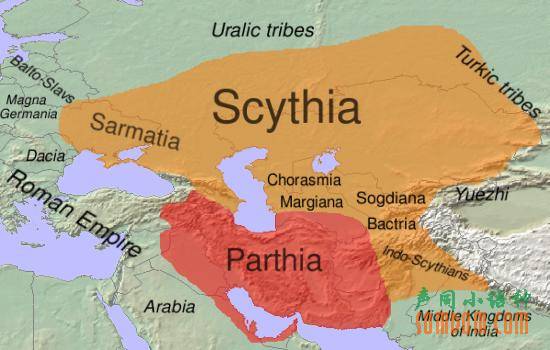|
伊朗语支简介 (来自维基百科)
伊朗语支 地理分布:西南亚, 中亚 谱系学分类:印欧语系 —— 印度-伊朗语族 —— 伊朗语支 分支: 西伊朗语支 东伊朗语支 ISO 639-2: ira 现代伊朗语支语言的分布:波斯语(黄)、普什图语(红)、俾路支语(浅绿)、库尔德语(绿),和其他较少使用者的语言。 图片:Iranian_languages_distribution.jpg 
伊朗语支是印欧语系的一个分支之一,属于印度-伊朗语族,分布在伊朗(波斯)、巴基斯坦、伊拉克、土耳其、高加索等地。该语族包括俾路支语、奥塞梯语、库尔德语、普什图语、波斯语等语言。 Today, there are an estimated 150-200 million native speakers of Iranian languages. The 2005 SIL enumerates 87 varieties of Iranian languages, per number of native speakers, the largest are Farsi (ca. 70 million), Pashto (ca. 40 million), Kurdish (35 million) and Balochi (ca. 7 million); to compare these numbers against those for other languages, see list of languages by number of native speakers. Name The 'Iranian' languages branch is so named because its principal member languages, including Persian, have been spoken in the area of the Iranian plateau since ancient times, however, as a linguistic classification, 'Iranian' implies no relation with the country of Iran. Iranian languages are spoken by many ethnic groups including Persians, Tajiks, Pashtus, Balochis, Talishis, Mezandaris, Sengesaris, Tati speakers, and Kurds (Kurmanci, Zazaki, Gorani). Early Iranian languages Historical distribution in 100 BC: shown is Sarmatia, Scythia, Bactria and the Parthian Empire. 图片:Scythia-Parthia_100_BC.jpg 
The Indo-Iranian languages are thought to have originated in Central Asia. The Andronovo culture is the suggested candidate for the common Indo-Iranian culture ca. 2000 BC. Together with the other Indo-Iranian languages, the Iranian languages are descended from a common ancestor, Proto-Indo-Iranian. This language split up into:
Linguistically, the Old Iranian languages are divided into two major families and several subclasses:
The northwestern branch included Median, and Parthian, while the southwestern branch included Old Persian. Middle Iranian languages What is known in Iranian linguistic history as the "Middle Iranian" era is thought to begin around the 4th century BCE lasting through the 9th century. Again, geographically, one can classify these into two main families, Western and Eastern.The Western family includes Parthian (Arsacid Pahlavi) and Middle Persian, while Bactrian, Sogdian, Khwarezmian, Saka, and Old Ossetic(Scytho-Sarmatian) fall under the Eastern category. The two languagesof the western group were linguistically very close to each other, butquite distinct from their eastern counterparts. On the other hand, theEastern group retained some proximity to Avestan. They were inscribedin various Aramaic-derived alphabets, which had evolved from the Achaemenid Imperial Aramaic. Middle Persian (Pahlavi), was the official language of the Sassanids. It was in usage from the 3rd century CE until the beginning of the 10th century. Pahlavi and Parthian were also the language of the Manichaeans, whose texts also survive in various non-Iranian languages, from Latin to Chinese. The Imperial Aramaic script used in this era experienced significant maturation. Arab conquest of Persia Following the Islamic Conquest of Persia (Iran), there were important changes in the role of the different dialects within the Persian empire. The old prestige form of Middle Iranian, also known as Pahlavi, was replaced by a new standard dialect called Dari as the official language of the court. The name Dari comes from the word darbar (دربار), which refers to the royal court, where many of the poets, protagonists, and patrons of the literature flourished (See Persian literature). The Saffarid dynastyin particular was the first in a line of many dynasties to officiallyadopt the new language in 875 CE. Dari is believed to have been heavilyinfluenced by regional dialects of eastern Iran, whereas the earlier Pahlavistandard was based more on western dialects. This new prestige dialectbecame the ancestor of modern Standard Persian. Medieval Iranianscholars such as Abdullah Ibn al-Muqaffa (8th century) and Ibn al-Nadim (10th century) associated the term "Dari" with the eastern province of Khorasan, while they used the term "Pahlavi" to describe the dialects of the northwestern areas between Isfahan and Azerbaijan (see Ancient Azari language), and "Parsi" ("Persian" proper) to describe the dialects of Fars.They also noted that the unofficial language of the royalty itself wasyet another dialect, "Khuzi", associated with the western province of Khuzestan. The Islamic conquest also brought with it the adoption of Arabicscript for writing Persian, Pashto and Balochi. All three were adaptedto the writing by the addition of a few letters. This developmentprobably occurred some time during the second half of the 8th century,when the old middle Persian script began dwindling in usage. The Arabicscript remains in use in contemporary modern Persian. Tajik script wasfirst Latinised in the 1920s under the then Soviet nationality policy. The script was however subsequently Cyrillicized in the 1930s under plans by USSR's government in Central Asia. The geographical area in which Iranian languages were spoken waspushed back in several areas by newly neighbouring languages. Arabicspread into some parts of Western Iran (Khuzestan), and Turkic languages spread through much of Central Asia, displacing various Iranian languages such as Sogdian and Bactrian in parts of what is today Turkmenistan, Uzbekistan and Tajikistan. Sogdian barely survives in a small area of the Zarafshan valley east of Samarkand, and Saka(as Sariqoli) in parts of southern Xinjiang as well as Ossetic in theCaucasus. Various small Iranian languages in the Pamirs survive thatare derived from Eastern Iranian. Turkic also displaced the Persianlanguage spoken in Azerbaijan. ClassificationIranian languages are divided into Eastern and Western subfamilies, totalling about 84 languages (SIL estimate). Of the most widely-spoken Iranian languages, Kurdish, Farsi, and Balochi are all Western Iranian languages, while Pashto is an Eastern Iranian language. 分类根据《民族语》的伊朗语支分类:
[ 本帖最后由 hongwei0315 于 2008-8-14 00:43 编辑 ] |
|
最新喜欢: |
|
沙发#
发布于:2012-01-03 23:45
xiexie楼主
|
|
|
板凳#
发布于:2011-11-15 00:13
学习了!了解了!
|
|
|
|
地板#
发布于:2010-08-22 22:31
波斯语的传播没能摆脱伊朗高原的束缚,但这也正是波斯人能够在阿拉伯人强大的扩张下还能保持自身独立性的主要原因。
|
|
|
4#
发布于:2010-06-14 22:10
|
|
|
|
7#
发布于:2010-03-01 11:57
|
|
|
|
|
9#
发布于:2009-12-29 15:24
塔吉克斯坦往西多出来一块是samarkand市,虽然行政上属于uzbecstan,但和bukhara一样,居民也是说波斯语
|
|
|
10#
发布于:2009-12-29 15:22
本帖最后由 eau 于 2009-12-29 15:25 编辑
布哈拉城(地图上在塔吉克斯坦西界再往西接近阿姆河)也是说波斯语,图上没显示 |
|
|
11#
发布于:2009-08-14 22:46
谢谢谢谢谢谢
|
|
|
14#
发布于:2008-08-15 21:52
回复 2楼 dariush 的帖子
应该的应该的~~ 大家一起努力! |
|









